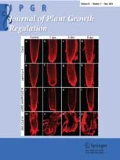Abstract
Plants accumulate a diverse array of natural products, which can serve either to defend the plant against various microbes in its environment or to attract various microbes, both beneficial and pathogenic. Plants must also attract pollinators, repel or poison herbivores, compete with other plant species, and protect themselves from environmental dangers such as high light intensities. Some compounds have been implicated in playing a role in multiple interactions. Although the structures vary immensely in size and complexity, most are derived from a limited number of core biosynthetic pathways. This review briefly summarizes the biosynthetic origins of phenylpropanoid (including simple phenolics, flavonoids, anthocyanins and isoflavonoids), polyacetate, terpenoid, and alkaloid classes of metabolites. Compounds reported to be important in plant-microbe, plant-animal, and plant-plant interactions will be given as examples of each of these classes. Other aspects of biosynthesis also will be discussed, including the timing or location of biosynthesis, the potential for genetic manipulation of these pathways, and various questions regarding the biosynthesis of these compounds.
Similar content being viewed by others
Author information
Authors and Affiliations
Rights and permissions
About this article
Cite this article
Paiva, N. An Introduction to the Biosynthesis of Chemicals Used in Plant-Microbe Communication. J Plant Growth Regul 19, 131–143 (2000). https://doi.org/10.1007/s003440000016
Issue Date:
DOI: https://doi.org/10.1007/s003440000016



